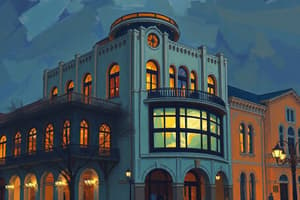Podcast
Questions and Answers
What is Art Deco?
What is Art Deco?
A style that refers to popular geometric works of the 1920s and 1930s.
What was a main moto of Art Deco?
What was a main moto of Art Deco?
Unity between art and industry.
Art Deco objects are not functional?
Art Deco objects are not functional?
False (B)
What does Art Deco express?
What does Art Deco express?
Decoration is the essence of Art Deco.
Decoration is the essence of Art Deco.
Carlo Mollino designed which table?
Carlo Mollino designed which table?
Mario Botta designed which chair?
Mario Botta designed which chair?
Flashcards
Art Deco
Art Deco
A style of visual arts and architecture from the 1920s-30s featuring geometric forms and decorative elements.
Unity between art and industry
Unity between art and industry
The philosophy behind Art Deco that emphasizes collaboration between artistic design and industrial production.
Functional objects
Functional objects
Items designed for practical use that are also aesthetically pleasing and mass-produced.
Iconographic symbols
Iconographic symbols
Signup and view all the flashcards
Severe geometry
Severe geometry
Signup and view all the flashcards
Streamlined design
Streamlined design
Signup and view all the flashcards
Alvar Aalto
Alvar Aalto
Signup and view all the flashcards
Brno Chair
Brno Chair
Signup and view all the flashcards
Carlo Mollino
Carlo Mollino
Signup and view all the flashcards
A.M. Cassandre
A.M. Cassandre
Signup and view all the flashcards
Study Notes
Art Deco Overview
- Art Deco refers to popular geometric works from the 1920s and 1930s.
- Art Deco design emphasizes unity between art and industry.
- Functional objects, mass-produced, and streamlined for mass consumption characterized the movement.
- It blends machine aesthetics with a desire for decorative elements.
Art Deco Design Principles
- Designs often reduced subject matter to pure iconographic symbols.
- Severe geometry was sometimes softened by smoke and fading reflections in artistic depictions.
- Furniture styles were simple, elegant, and often incorporating exotic elements.
- Decoration was a key element of Art Deco style.
Specific Art Deco Examples
- L'Atlantique poster: A poster by A.M. Cassandre, promoting a ship.
- North Star poster: Designed by A.M. Cassandre (1927). A poster for a Paris to Amsterdam night train.
- Le Corbusier's 1928 Tube Steel chairs: A notable example of a chair design using tube steel.
- Brno Chair: Created by Ludwig Mies Van der Rohe, utilizing flat steel.
- Tubular Steel chair: A chair design utilizing tubular steel framework.
- MR Stuhl (chair): Designed by Mies van der Rohe and manufactured by Jos. Müller. Materials included nickel-plated or chrome-plated steel.
- Alvar Aalto's 1937 glass vase: Demonstrating unique and distinct form and structure.
- "Arabesque" table: Created by Carlo Mollino. Often showcases specific artistic traits of the period.
- Seconda chair: A design by Mario Botta.
Studying That Suits You
Use AI to generate personalized quizzes and flashcards to suit your learning preferences.




